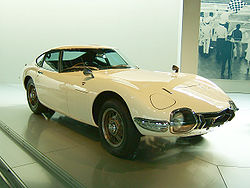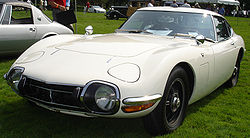| Toyota 2000GT | |
|---|---|
 | |
| Manufacturer | Toyota Motor Corporation and Yamaha Motor Corporation (joint project) |
| Production | 1967–1970 337 produced |
| Predecessor | Toyota Sports 800 |
| Successor | Toyota Celica, Toyota Supra |
| Class | Sports car |
| Body style(s) | 2-door coupe |
| Layout | FR layout |
| Engine(s) | 2.0 L 3M I6 2.3 L 2M I6 |
The Toyota 2000GT was a sports car produced in very limited numbers by Toyota in Japan. First seen at the Tokyo Motor Show of 1965, production vehicles were built between 1967 and 1970. It revolutionized the automotive world's view of Japan, formerly seen as a producer of imitative and stodgily practical vehicles, and showed that the Japanese makers could produce a sports car to rival those of Europe.
Reviewing a pre-production car in 1967, Road & Track magazine summed up the 2000 GT (sic) as "one of the most exciting and enjoyable cars we've driven", and compared it favorably to the Porsche 911. Today, the car is seen as the first seriously collectible Japanese car, the first "Japanese Supercar", and examples change hands for fairly high prices.
Background
Much of the work was done by Yamaha, who in addition to their wide product range of the time also did much work for other Japanese manufacturers. Many credit the German-American designer Albrecht Goertz, a protegé of Raymond Loewy, as designer. He had gone to Yamaha in Japan in the early 1960s to develop a two-seater sports car for Nissan. A prototype was built, but Nissan decided eventually not to pursue the project. Yamaha also worked for Toyota, then perceived as the most conservative of the Japanese auto makers. Wishing to improve their image, Toyota accepted the proposal instead, but with a design of their own penned by Toyota designer Satoru Nozaki.
Styling
Many cite the Jaguar E-Type as an influence on the lines, but the design is widely considered a classic in its own right. The smoothly flowing bodywork was executed in aluminium, and featured pop-up headlights as well as large driving lamps like that on the Toyota Sports 800 in fixed locations on either side of the grille, with plexiglas covers over them. The design scarcely featured bumpers at all, and the plexiglas driving lamp covers in particular are rather easily damaged. The car was extremely low, just 45.7 in (116 cm) to the highest point of the roof. In 1969, the front of the car was modified slightly, making the driving lamps smaller and changing the shape of the turn signals. The rear turn signals were enlarged at the same time, and some alterations were made inside to modernise the interior. The last few vehicles were fitted with air conditioning and had automatic transmission as an option. These cars had an additional scoop fitted underneath the grille to supply air to the A/C unit. Two convertibles were built for the James Bond film You Only Live Twice, but a factory-produced convertible was never offered for sale to the public during the car's production run.
Technical details
The engine was a 2.0 L (121 in³) straight-6 (the 3M) based on the engine the top-of-the-line Toyota Crown sedan. It was transformed by Yamaha with new double overhead camshaft heads into a 112 kW (150 hp) sports car engine. Carburation was through three two-barrel Solex 40 PHH units. Nine special MF-12 models were also built with the larger 2.3 L 2M engine. The car was available with three different final drives; optioned with the 4.375 ratio version, the car was said to be capable of reaching 135 mph (217 km/h).
The engine was mounted longitudinally and drove the rear wheels through a five-speed manual transmission. A limited slip differential was fitted, and in a first for a Japanese car, all-round power-assisted disc brakes. The atypical emergency brake gripped the rear disc directly.
The interior offered comfortable, if cramped, accommodation and luxury touches like a rosewood-veneer dashboard and an auto-seeking radio tuner. At the time, Road & Track felt that the interior was up to par for a "luxurious GT", calling it an impressive car "in which to sit or ride - or simply admire."
Production
An absolutely minuscule 351 (regular production cars) of the 2000GT were built, figures as low as specialist Italian supercar construction. According to Toyota and Yamaha data, there were 233 MF10s, 109 MF10Ls, and nine MF12Ls. All were actually built by Yamaha; it took two years for production vehicles to emerge. In America, the 2000GT sold for about $6,800, much more than contemporary Porsches and Jaguars. It is believed that no profit was made on the cars despite their high price; they were more concept cars and a demonstration of ability than a true production vehicle. About 60 cars reached North America and the others were similarly thinly spread worldwide. Most 2000GTs were painted either red or white.
Ironically, the number of toy 2000GTs made must far outstrip the amount of real cars produced. The car was widely modelled when new, and is still a popular subject with model manufacturers. Scale renditions of the car have been produced by Corgi Toys, Mebetoys, Playart, Yatming, Tekno, Diapet and numerous other manufacturers, while plastic kits have been also been produced in numerous scales by companies including Airfix. In addition to models of the coupe, several of these companies replicated the convertible produced for the James Bond film You Only Live Twice. The Bond car has appeared as a diecast model and in plastic kit form, and although no convertible 2000GT was ever sold to the public, some makers manufactured model convertible 2000GTs which clearly replicated the Bond car, but were finished in colours other than the white of the car in the film. Notably, Corgi and Playart both did this, as did kit manufacturer MPC.
Racing
Toyota entered the 2000GT in competition at home, coming third in the 1966 Japanese Grand Prix and winning the Fuji 24-Hour Race in 1967. In addition, the car set several FIA world records for speed and endurance in a 72-hour test. Unfortunately, the record car was destroyed in a pace car accident and eventually scrapped. These records shortly prompted Porsche to prepare a 911R especially to beat this record.
Carroll Shelby would also enter a pair of 2000GTs to compete in the SCCA production car races competing in the CP category. Initially Shelby built three cars, including one spare, although performing well in the 1968 season, that was the only season in the US that the car competed in. Toyota took back one of the cars and rebuilt it into a replica of their record car which still resides in Japan. Nowadays the two remaining cars still reside in the United States.
Movie and TV appearances
2000GT Open-Top, the “Bond Model”
The 2000GT made its most famous screen appearance in the 1967 James Bond movie You Only Live Twice. Even though the car was never commercially available as a convertible, two were made specially for the film, although as they did not have roofs - just an upholstered hump at the rear of the cabin to simulate a folded top. They were not really true convertibles. Prior to the decision to make fully roofless cars, building the car as a targa was tried, allegedly due to Sean Connery's height not allowing him to fit into the ultra-low coupe version. This retained the hatchback of the original car, but eliminated the rear side windows. However, when the Targa was completed, Connery's head stuck out of the top to such an extent that it was decided it looked too ridiculous and that roofless versions would have to be made if the car was to be featured in the film (its lead competition for the role was said to be the then-new Chevrolet Camaro.)
Originally, the Toyota was to be driven by 007 himself, but script changes meant that it ended up as the car of his Japanese contact Aki, although as actress Akiko Wakabayashi could not drive, all the actual driving was done by stuntmen in wigs, and all her close-up scenes were filmed while the car was stationary. Some of the close-ups were actually filmed using another white convertible as a stand-in, as in the finished film some shots of Bond and Aki driving clearly show the car's dashboard, and this looks totally different to that of a 2000GT. Budget cuts also meant that of the three planned car chases, only one eventually ended up on screen. Nevertheless, the 2000GT did get some memorable screentime, being used to evade villains in a Toyota Crown. The car had none of the defence mechanisms enjoyed by Bond's own vehicles, although it did feature a TV/radio communications device in the rear cabin. Corgi Toys modelled the car, and added rockets which could be fired out of the boot, although these do not appear in the film.
Two cars were built for the film. One of these was eventually located by Toyota in Hawaii and has since been restored and put on display at Toyota's headquarters in Japan. The other was resprayed blue, and is believed to have been used for racing-ciruit testing in Ginza. Its current wherabouts are unknown, although it is believed it may have been scrapped in the early 1970s. Several 2000GTs have been converted into true convertibles with actual roofs by private owners since, and one was even built into a replica of the unused Targa model. The Cars of the Stars museum located a wrecked 2000GT coupe in a South African scrapyard which was turned into a replica of the You Only Live Twice car. It is now on display at the museum, and has been fitted with the original communications device interior panel from the car in the film.
Television
2000GT's made appearances in the TV series The Ugliest Girl in Town and Hawaii Five-0. The car which appeared in The Ugliest Girl in Town was formerly owned by Twiggy. It was given to her by Toyota as a gift in return for her participating in the car's launch. At the time, she could not drive so placed the car in storage. Toyota subsequently bought it back from her and lent it to the makers of the short-lived comedy series. Originally gold, with the 1968 UK registration number UBY2F, the car had psychedelic motifs added for its TV appearance. On the show, art mirrored life as it was given to the lead character, model "Timmie," who was really a man in drag. The car has been in the possession of Toyota Motor Sales, USA, for a number of years. During this time the car was painted red, but in 2006 it was resprayed gold. It is currently at the Toyota USA Automobile Museum in California.
Today
Although not nowadays quite as well known to the general public as later Japanese sports cars like the Nissan Z, the 2000GT is regarded by many collectors as possibly the first highly collectible Japanese car. As of 2004, good examples can reach very high auction prices (reaching even $200,000 at auctions), though parts availability is a problem. Some combination of interesting provenance (particularly the first and second owners) and cosmetic perfection seems to be the formula for the highest auction values. Panel fit, overall finish, and interior quality/originality seem to be the primary value factors.








![Validate my RSS feed [Valid RSS]](valid-rss-rogers.png)















































































ไม่มีความคิดเห็น:
แสดงความคิดเห็น